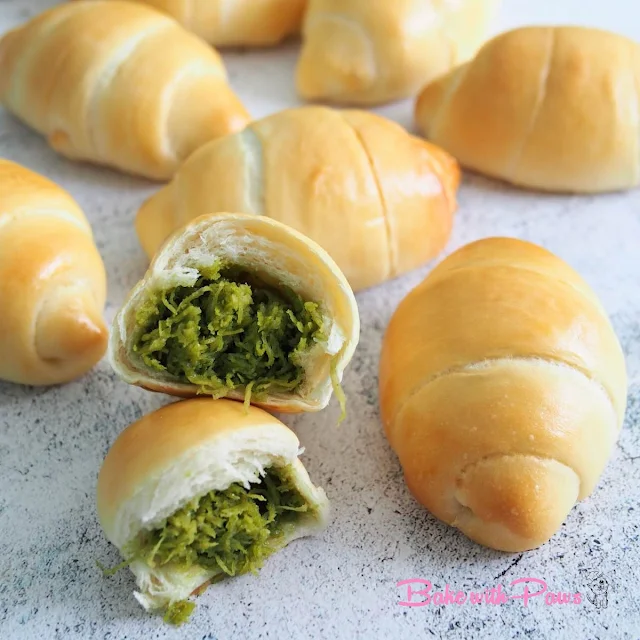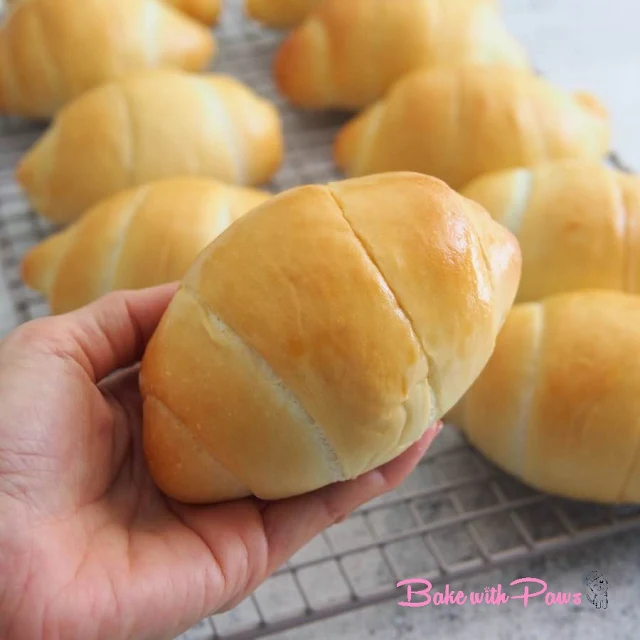Breads (Yeast) - Buns/Rolls
Pandan Coconut Buns
April 13, 2023
| Recipe by Bake with Paws
Scroll to the bottom of the page for "PRINT RECIPE" ⬇
After sharing the Coconut Buns Sourdough version, there has been a lot of requests for a yeast version. Here is the instant yeast version of Coconut Buns. I made a pandan coconut filling this time instead of the usual gula melaka coconut. To be honest, I think it tastes even better. Coconut, pandan and gula melaka is a combination that never goes wrong.
I combined the yudane method and overnight retard in this recipe and I found the bun texture is even softer. However, you can still do the same day bake.
If you have any questions regarding this recipe or any other post, please leave me a comment in the “LEAVE A COMMENT” link and I will reply you as soon as possible. Do tag me on Instagram @Bakewithpaws if you attempt on this recipe.
How To Make Coconut Buns
Yields: 10 buns
INGREDIENTS:
Yudane Dough:
70g bread flour (I used Japan High Gluten Flour)
70g boiling water
Main Dough:
280g bread flour (I used Japan high gluten flour, 12% protein)
1 1/4 tsp (4g) instant yeast
15g caster or brown sugar
1 tsp salt
140g full cream milk, cold (whole milk)
60g water, cold (Reserve 20g first, add in later if too dry. I used 50g of water)
30g butter, room temperature
Egg Wash:
1 egg + 1 Tbsp water, whisked
Pandan Coconut Filling:
250g grated fresh coconut (only the white part)
50g palm sugar (gula melaka)
80g water
Pinch of salt
120g pandan juice (10 pandan leaves around 45g + 120g water)
2 tsp corn starch + 2 Tbsp water
Utensils:
Baking tray
METHOD:
- Coconut Filing:
- Pandan Juice - Cut pandan leaves into chunks. In a food processor, blend pandan with water until fine. Squeeze out the juice through a sieve. Set aside.
- Combine palm sugar and 80g water in a small pot. Boil till sugar dissolved. Sieve the syrup to remove any impurities.
- Combine gula melaka syrup and pandan juice in a sauce pan. Add in grated coconut and salt. Stir well and cook over low medium heat.
- Add in corn starch mixture.
- Cook till the coconut is cooked and turn slightly dry. Stir constantly to prevent burning.
- Dish out and set aside to cool.
- Divide the filling into 10 portions and and roll into an oblong weighing 30g each. You may have some balance.
- Yudane:
- Add bread flour in a bowl, pour the boiling water and mix well with spatula or spoon until no dry flour.
- Cling film and leave on the counter for at least 4 hours or overnight in the fridge.
- Take out from the fridge 30 minutes before using to return to room temperature.
- Kneading:
- Put all ingredients (except butter), including yudane dough into a bowl of stand mixer.
- Slightly combine the mixture by hand with the paddle attachment before turning on the machine so that the flour will not splash out. Using the paddle attachment, mix for 2 minutes or until all incorporated.
- Change to hook attachment and knead for another 2 minutes or until the dough comes together. Add in butter and continue knead for about 8 minutes or or until the dough come together.. But, the dough is not very silky and smooth. You also do not need to achieve window pane stage because the long overnight retard in the fridge will allow adequate gluten development. The whole kneading process, I stopped few times to scrape down the dough from the hook to be sure it is evenly kneaded and also to prevent the motor from overheating.
- 1st Proofing:
- Cover the bowl and transfer to refrigerator for overnight retard, about 8 – 12 hours. I retarded in the fridge for 10 hours. I found with overnight retard the texture is even softer compared with same day bake.
- You may also do the same day bake - Let the dough rise in a warm place for 60 - 90 minutes until double in size. I usually left the dough in the same mixing bowl and cover with cling film.
- Shaping:
- Take out dough from the fridge and leave on counter for around 15 mins to soften and relax the dough.
- Transfer the dough to a clean surface slightly dusted with flour, divide dough into 10 equal portions (approx.65.3g each). Please use a kitchen scale if you want to be exact.
- Shape each dough into a ball. Finish all the dough.
- Roll each dough ball into carrot shape. Finish all the dough.
- Flatten the dough with a rolling pin. Place an oblong coconut filling then roll up like shaping a croissant. Please refer to the diagram below.
- Place the buns on the lined baking tray.
- Final Proofing:
- Let the buns rise at warm place (my room temperature around 29 - 30C) for another 30 - 45 minutes until the dough rise about double in size.
- Baking:
- Preheat oven at 190C - 200C (top & bottom heat) or 180C (fan-forced) for 10 - 15 minutes.
- Brush with egg wash.
- Bake in a preheated oven for about 15 - 16 minutes, or until golden brown.
- Remove bread from oven and let them cool on rack.
Pandan Coconut Filling
Yudane Dough
Main Dough
GENERAL NOTES:
GLUTEN DEVELOPMENT & WINDOWPANE TEST
Gluten forms when flour comes in contact with water. Hydration of the flour causes the sticky and stretchy protein to form, giving structure to the bread. This makes your bread trap air and rise.
Gluten in dough can be developed by autolyse, resting, kneading or folding.
The windowpane test is used to determine whether the dough has been sufficiently kneaded. By gently pulling the dough (or you may pinch off some dough) and trying to stretch it into a thin membrane. If you are able to stretch the dough paper thin and translucent without tearing, then the gluten is fully developed. However, if you can stretch it without tearing but the membrane is not transparent, then the gluten is not yet fully developed.
However, from my experience not all the recipe can achieve a thin and translucent window pane stage easily. For example low hydration and low fat dough. For such recipes, a reasonable window pane is good enough and it can be left to rest. Gluten will continue to develop while resting. Exercising restraint to not over-knead the dough prevents the gluten from being overworked and broken. Some of you may have experienced the dough breaking during the second proofing. It is because the dough is over kneaded.
The total kneading time for me is usually 15 minutes at low speeds except brioche dough with high fat percentage or dough using liquid fat which usually takes a little longer (maybe 18-20 mins).
From my experience, I found that high hydration dough with high percentage of fat will be easy to stretch and achieve a paper thin windowpane stage.
KNEADING TIME
For kneading, please regard the timing provided as an indication only. It is only meant as a guide. Timing may differ depending on the brand of flour and electric mixer used. The protein content may vary from one brand of flour to another.
FLOUR
The right flour plays a very important role in bread making. To achieve fluffy, soft and light bread, I used Japan High Gluten Flour in most of my bread baking. The protein content is around 12 - 13%.
HYDRATION
The liquid measurement given is also a guide. It is advisable to always reserve some liquid and not add it all in one go. This would give you the opportunity to adjust if necessary. If dough is too dry, add the reserve liquid one tablespoon at a time until the right consistency. This is because each flour absorbs water and hydrates differently.
PROOFING
Please note that the proofing timing may also vary depending on your climate and environment. The humidity and temperature at your place will influence how dough rises.
If you are unable to judge by just looking at the dough, you can do the finger poke test:
- First Proofing:
- Lightly flour or oil your finger or knuckle, gently poke in the centre of the dough then remove your finger. If it bounces back immediately without any indentation then it needs more time.
- If the indentation stays and it doesn’t bounce back or if the dough collapses, then the it is over proved.
- If it bounces back just a little, then the dough is ready to be punched down and shaping.
- Second Proofing:
- Lightly press the side of the proved dough with your finger. If it bounces back immediately without any indentation, it means the dough is under proved and needs more time before baking.
- If the indentation stays and it doesn’t bounce back, it means it has been over proved.
- If the indentation slowly bounces back and leave a small indentation, it is ready to bake.
- There will be a final burst of rising once the bread is placed to bake in the oven and it is called oven spring.
WRINKLE TOP OR SHRINKING
If your bread collapses or gets wrinkled on top after removing from oven, it could be because your dough over proved during the second proofing. Please proof until it rises 80 - 90% in size or is slightly below the rim of the pan.
BAKING TEMPERATURE & TIME
Do also note that the baking temperature and timing provided are what works for my oven and should also be regarded as a guide only. Every oven behaves a little differently, so please adjust accordingly for your oven.
Labels:
Breads (Yeast) - Buns/Rolls,








Thanks for the recipe. How long can these buns keep in an air right container at room temperature?
ReplyDeleteHi, thank you for your interest in this recipe!
DeleteIf you’re in a warm climate (like a tropical country), you can leave it out for up to one day. After 24 hours, it’s best to store it in the fridge. In colder climates, it may stay fresh at room temperature for 2 to 3 days.
Since my kitchen is warm, I refrigerated it after 24 hours and warmed it up before eating.
Enjoy! 😊